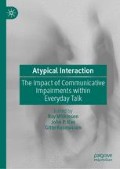Abstract
Classroom talk is typically asymmetric since teachers retain high authority for the information. Yet downgrading teacher authority is crucial for the education of children with special needs. The data involve teachers and children with primary language difficulties. Teacher topic initiations (e.g. ‘tell me about’) signal that the child has more authority for talking about the topic at hand. Topic invitations are strongly suited to the children’s involvement in decisions about topical content. When teachers correct the children’s grammar or phonology, without exposure, the children do not tend to produce the correct item; but when they expose the corrections the children do tend to produce the correct item. Finally, correction-initiations that target the location or the nature of the trouble generate more information from the children and their authority is increased.
Access this chapter
Tax calculation will be finalised at checkout
Purchases are for personal use only
References
American Psychiatric Association. (2013). Diagnostic and statistical manual of mental disorders (5th ed.). Washington, DC: Author.
Button, G., & Casey, N. (1984). Generating topic: The use of topic initial elicitors. In Structures of social action. Cambridge: Cambridge University Press.
Button, G., & Casey, N. (1985). Topic nomination and topic pursuit. Human Studies,8, 3–55.
Cazden, C. B., & Beck, S. W. (2003). Classroom discourse. In A. Graesser, M. Gersbacher, & S. Goldman (Eds.), Handbook of discourse processes (pp. 165–198). Linden, NJ: LEA.
Department for Education. (2015). Special educational needs and disability code of practice 0 to 25 years. London: DfE.
Drew, P. (1997). Open class repair initiators in response to sequential sources of trouble in conversation. Journal of Pragmatics, 28, 69–101. https://doi.org/10.1016/s0378-2166(97)89759-7.
Heritage, J., & Raymond, G. (2005). The terms of agreement: Indexing epistemic authority and subordination through talk in interaction. Social Psychology Quarterly,68, 15–38. https://doi.org/10.1177/019027250506800103.
Jefferson, G. (1987). On exposed and embedded correction in conversation. In G. Button & J. Lee (Eds.), Talk and social organization (pp. 86–100). Clevedon: Multilingual Matters.
Macbeth, D. (2004). The relevance of repair for classroom correction. Language in Society,33, 703–736. https://doi.org/10.1017/S0047404504045038.
McHoul, A. (1990). The organization of repair in classroom talk. Language in Society,19(3), 349–377. https://doi.org/10.1017/S004740450001455X.
Mehan, H. (1979). Learning lessons: Social organization in the classroom. Cambridge, MA and London: Harvard University Press.
Norbury, C., Vamvakas, G., Gooch, D., Baird, G., Charman, T., Simonoff, E., et al. (2017). Language growth in children with heterogeneous language disorders: A population study. Journal of Child Psychology and Psychiatry,58, 1092–1105. https://doi.org/10.1111/jcpp.12793.
Radford, J. (2010a). Practices of other-initiated repair and correction in SSLD classroom discourse. Applied Linguistics,31, 25–44. https://doi.org/10.1093/applin/amn046.
Radford, J. (2010b). Adult participation in children’s word searches: On the use of prompting, hinting and supplying a model. Clinical Linguistics and Phonetics, 83–100. https://doi.org/10.3109/02699200903407149.
Radford, J., Ireson, J., & Mahon, M. (2006). Triadic dialogue in oral communication tasks: What are the implications for language learning? Language and Education,20, 191–210. https://doi.org/10.1080/09500780608668723.
Radford, J., Ireson, J., & Mahon, M. (2012). The organisation of repair in SSLD classroom discourse: How to expose the trouble source. Journal of Interactional Research in Communication Disorders,3, 143–165. https://doi.org/10.1558/jircd.v3i2.171.
Radford, J., & Tarplee, C. (2000). The management of conversational topic by a ten-year-old child with pragmatic difficulties. Clinical Linguistics and Phonetics,14, 387–403. https://doi.org/10.1080/02699200050051092.
Rusk, F., Sahlstrom, F., & Porn, M. (2017). Initiating and carrying out L2 instruction by asking known answer questions. Linguistics and Education,38, 55–67.
Schegloff, E. A. (1997). Practices and actions: Boundary cases of other-initiated repair. Discourse Processes,23, 499–545. https://doi.org/10.1080/01638539709545001.
Schegloff, E. A. (2007). Sequence organisation in interaction: A primer in conversation analysis. Cambridge: Cambridge University Press.
Schegloff, E. A., Jefferson, G., & Sacks, H. (1977). The preference for self-correction in the organization of repair in conversation. Language,53, 361–382.
Sidnell, J. (2012). Who knows best? Evidentiality and epistemic asymmetry in conversation. Pragmatics and Society,3, 294–320.
Author information
Authors and Affiliations
Editor information
Editors and Affiliations
Rights and permissions
Copyright information
© 2020 The Author(s)
About this chapter
Cite this chapter
Radford, J. (2020). Increasing Learner Authority in the Classrooms of Children with Speech, Language and Communication Needs. In: Wilkinson, R., Rae, J.P., Rasmussen, G. (eds) Atypical Interaction. Palgrave Macmillan, Cham. https://doi.org/10.1007/978-3-030-28799-3_10
Download citation
DOI: https://doi.org/10.1007/978-3-030-28799-3_10
Published:
Publisher Name: Palgrave Macmillan, Cham
Print ISBN: 978-3-030-28798-6
Online ISBN: 978-3-030-28799-3
eBook Packages: Behavioral Science and PsychologyBehavioral Science and Psychology (R0)

